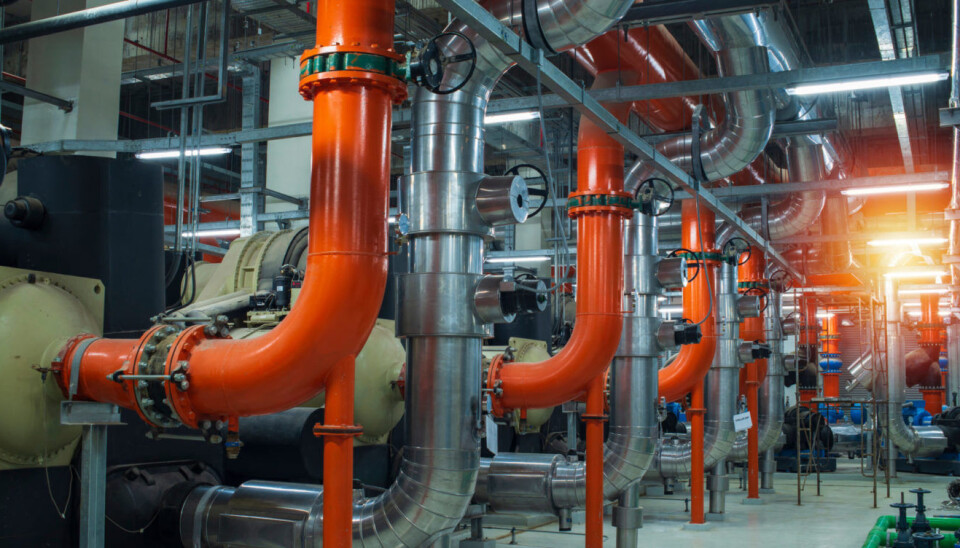THIS ARTICLE/PRESS RELEASE IS PAID FOR AND PRESENTED BY SINTEF - read more

Suddenly everyone wants ‘super-hot’ heat pumps
High-temperature heat pumps are no longer simply for idealists. They’re contributing to more than just climate accounting, and industrial companies are standing in line to learn more.
SINTEF has developed the world’s ‘hottest’ heat pump together with its industrial partners and colleagues at NTNU. It recently held its third conference on the topic of high-temperature heat pumps.
“It was only five years ago that we had to convince the 50 or so attendees why they should be using heat pumps at all,” senior research scientist Michael Bantle says. “This time we had to call a halt after we received 200 registrations because there simply wasn’t enough room to meet demand."
More economic than ever
Bantle is very pleased with developments. Today, end users are standing in line to get their hands on high-temperature heat pumps. They’re taking CO₂ prices and, not least, electricity prices into account. Record energy bills are making heat pumps more economic than ever.
The heat pumps we use at home, in the office or in our shops do not need to generate such high temperatures. It is industrial users that need very hot water or process steam. Many companies operate using temperatures of less than 180 degrees, and they can achieve this using the heat pumps developed in Trondheim.
“The technology is now available at industrial scale. This enables us to design a heat pump generating temperatures of 150 degrees or process steam at 5 bar," Bantle says.
The heat pumps have also made the leap from the prototype stage to commercial systems that can supply heat over a lifetime of at least 20 years.
Not just for idealists
“The potential is much greater, given that energy prices continue to skyrocket as they have been doing during the last twelve months,” says Bantle. “You no longer have to be an idealist to invest in this type of equipment. Now you can earn money – at least in the long term."
Suddenly, SINTEF is even getting enquiries from the US, where industries are only interested in oil and gas for heating.
“All of a sudden they’re realising that they’re at least ten years behind us because they haven’t been developing heat pumps at all,” says Bantle.
He is noting that current energy prices are providing a major incentive for those working with more climate-friendly systems such as heat pumps.

A further motivation is that heat pumps reduce the need for primary energy.
We’re currently used to obtaining all the electricity we need from our suppliers – we simply hook ourselves up to the grid. But if ‘everything’ suddenly becomes electrified, bottlenecks will develop in the energy supply system. This is where heat pumps can play an important role in the energy grid going forward because they can utilise waste heat generated by industries and at the same time help to reduce electricity consumption.
“An industrial company can thus meet its energy needs by using less electricity rather than via direct electrification,” Bantle says.
Not enough people
“It is becoming increasingly expensive to be a polluter," says Bantle. “Manufacturers simply do not have the capacity to meet the current demand for heat pumps. In Norway, there are at least five start-up companies manufacturing high-temperature heat pumps. All of them are doing well and can deliver everything they manufacture as soon as the equipment is ready."
In other countries, potential customers are not getting their hands on the high-temperature heat pumps they want.
“Suddenly a market has emerged,” Bantle says. “It’s surprising how quickly conditions have changed. All the talk is now about integration. How can I adapt my facility to accommodate heat pumps? No two facilities are the same, so there are no standardised processes. Each integration must be carried out from scratch."
The result is that the heat pump sector is in need of more skilled specialists. It is also being impacted by the same issues facing other sectors that depend on metals and electronics, in particular the current shortage of raw materials, parts and components.
Scandinavia is one step ahead
“This is a universal issue for all projects at the moment,” says Bantle. “There is a lot of uncertainty. First of all because of the Covid pandemic, and then the war in Ukraine. All of this impacts on supplies that you didn’t know you needed. Delivery times are now two months or perhaps two years for orders that used to take two weeks."
However, Bantle is now seeing some light at the end of the tunnel, both for industry in Scandinavia, and for those students studying heat and refrigeration engineering at NTNU.
“Here in Scandinavia, we’re one step ahead when it comes to heat pumps,” he says. “We have the expertise and a reference facility where we can demonstrate that new things work. Out there in the rest of Europe, a lot of head scratching is going on. We have to distance ourselves from a reliance on Russian oil and gas. Not just because of the environment, but in the interests of our energy supply security."
See more content from SINTEF:
-
Propellers that rotate in opposite directions can be good news for large ships
-
How Svalbard is becoming a living lab for marine restoration
-
New study: Even brand-new apartments in cities can have poor indoor air quality
-
Fresh hope for patients with chronic inflammatory bowel disease
-
Testing a giant ship: May take five kilometres to stop
-
A robot is helping researchers hunt for the best cancer warriors






































